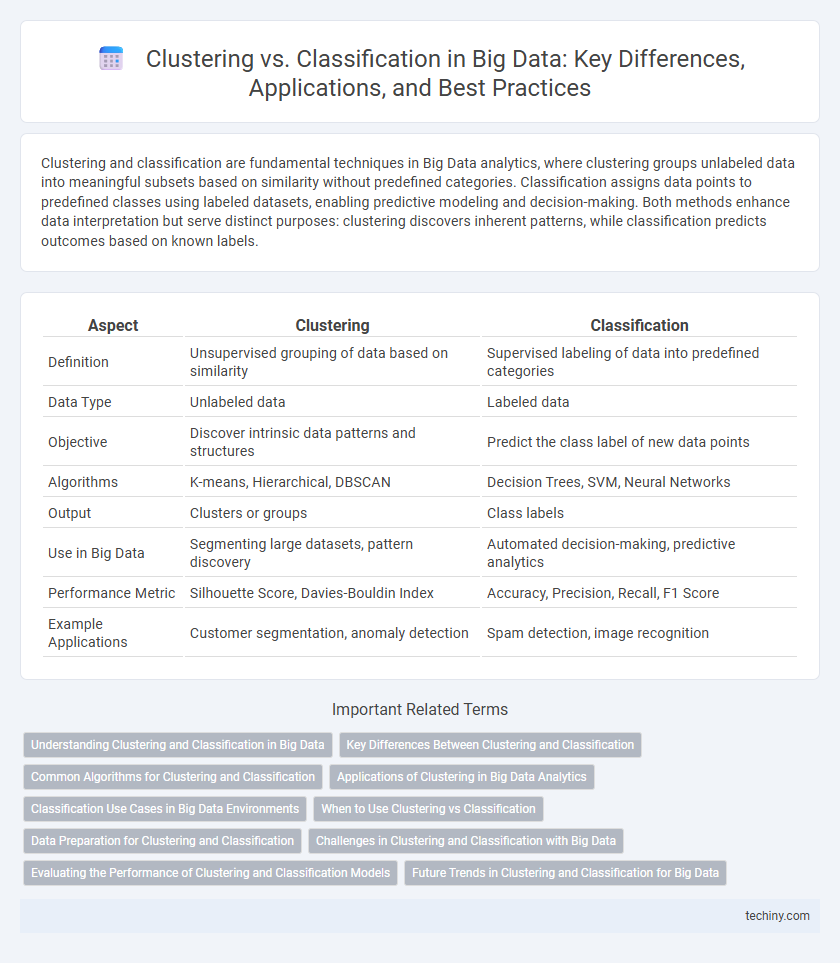Clustering and classification are fundamental techniques in Big Data analytics, where clustering groups unlabeled data into meaningful subsets based on similarity without predefined categories. Classification assigns data points to predefined classes using labeled datasets, enabling predictive modeling and decision-making. Both methods enhance data interpretation but serve distinct purposes: clustering discovers inherent patterns, while classification predicts outcomes based on known labels.
Table of Comparison
| Aspect | Clustering | Classification |
|---|---|---|
| Definition | Unsupervised grouping of data based on similarity | Supervised labeling of data into predefined categories |
| Data Type | Unlabeled data | Labeled data |
| Objective | Discover intrinsic data patterns and structures | Predict the class label of new data points |
| Algorithms | K-means, Hierarchical, DBSCAN | Decision Trees, SVM, Neural Networks |
| Output | Clusters or groups | Class labels |
| Use in Big Data | Segmenting large datasets, pattern discovery | Automated decision-making, predictive analytics |
| Performance Metric | Silhouette Score, Davies-Bouldin Index | Accuracy, Precision, Recall, F1 Score |
| Example Applications | Customer segmentation, anomaly detection | Spam detection, image recognition |
Understanding Clustering and Classification in Big Data
Clustering in Big Data involves grouping similar data points without predefined labels, enabling pattern discovery and anomaly detection across massive datasets. Classification assigns data to predefined categories using labeled training data, making it essential for predictive analytics and decision-making processes. Both techniques handle high-dimensional, large-scale data efficiently but serve different purposes: clustering for exploratory analysis and classification for supervised prediction.
Key Differences Between Clustering and Classification
Clustering groups unlabeled data into distinct clusters based on inherent similarities, while classification assigns predefined labels to data based on trained models. Clustering is unsupervised learning, useful for pattern discovery, whereas classification is supervised learning that relies on labeled datasets for predictive analysis. Key differences also include their purpose: clustering seeks to explore data structure, whereas classification aims to predict outcomes with known categories.
Common Algorithms for Clustering and Classification
Common clustering algorithms in big data include K-Means, DBSCAN, and hierarchical clustering, which group data points based on similarity without predefined labels. Classification algorithms such as Decision Trees, Support Vector Machines (SVM), and Random Forest are supervised methods that assign labels to data based on training sets. Both approaches leverage large datasets to uncover patterns, with clustering enabling unsupervised insights and classification providing targeted prediction models.
Applications of Clustering in Big Data Analytics
Clustering in Big Data Analytics enables the grouping of vast datasets into meaningful segments without predefined labels, facilitating customer segmentation, anomaly detection, and market basket analysis. It supports pattern recognition in complex data, driving personalized marketing strategies and fraud detection. Clustering algorithms such as K-means, DBSCAN, and hierarchical clustering handle high-velocity, high-volume data to uncover hidden insights critical for decision-making.
Classification Use Cases in Big Data Environments
Classification in big data environments is pivotal for applications such as customer segmentation, fraud detection, and predictive maintenance, where labeled data is abundant and immediate decision-making is crucial. Techniques like decision trees, support vector machines, and neural networks efficiently process vast datasets to categorize information into predefined classes, enhancing targeted marketing and risk management. This supervised learning approach contrasts with clustering by focusing on known labels, enabling precise predictions and improving operational outcomes in dynamic big data landscapes.
When to Use Clustering vs Classification
Clustering is ideal for exploring large datasets without predefined labels, enabling the discovery of natural groupings or patterns in Big Data environments. Classification is best used when the dataset includes labeled instances and the goal is to predict categorical outcomes based on input features. Choosing between clustering and classification depends on whether target labels are available and whether the objective is pattern discovery or supervised prediction in Big Data analytics.
Data Preparation for Clustering and Classification
Data preparation for clustering focuses on selecting relevant features and scaling data to enhance similarity measures, often utilizing normalization and dimensionality reduction techniques to improve centroid accuracy. In classification, data preparation emphasizes labeled data quality, balancing classes, and feature engineering to boost model accuracy and reduce bias. Both processes require handling missing values and outlier detection but differ in their approach to feature selection based on their unsupervised or supervised nature.
Challenges in Clustering and Classification with Big Data
Handling Big Data in clustering faces challenges such as high dimensionality, which complicates similarity measurements and increases computational costs, leading to inefficient cluster formation. Classification struggles with issues like class imbalance and the need for scalable algorithms that can process vast, streaming datasets without compromising model accuracy. Both techniques require robust data preprocessing, feature selection, and algorithm optimization to manage noise, heterogeneity, and evolving data patterns inherent in Big Data environments.
Evaluating the Performance of Clustering and Classification Models
Evaluating the performance of clustering models relies on metrics such as silhouette score, Davies-Bouldin index, and adjusted Rand index to measure cluster cohesion and separation without predefined labels. Classification models are assessed using accuracy, precision, recall, F1 score, and ROC-AUC, which require labeled data to evaluate prediction correctness and class balance. Effective evaluation in big data applications involves selecting metrics aligned with specific data characteristics and analysis goals for accurate model validation.
Future Trends in Clustering and Classification for Big Data
Future trends in clustering and classification for big data emphasize the integration of deep learning algorithms to enhance accuracy and scalability in handling high-dimensional datasets. Advances in unsupervised and semi-supervised learning techniques enable more dynamic and adaptive models, improving real-time data analysis and decision-making processes in industries such as healthcare and finance. Emerging frameworks that combine edge computing with cloud resources optimize the processing speed and resource efficiency of clustering and classification tasks in complex big data environments.
Clustering vs Classification Infographic

 techiny.com
techiny.com